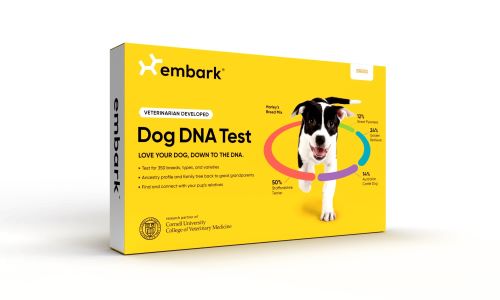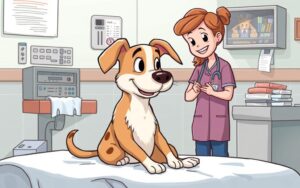
Signs Your Dog May Be Sick, As I witness my dog’s boundless energy and joyous tail wags, it’s hard to imagine that beneath that cheerful exterior, they might be harboring secret discomfort. It’s a troubling thought: **What if your dog is sick and you don’t even know it?** Understanding the select 5 warning signs your dog may be sick is not just pet care advice; it’s a crucial skill that could save your furry friend’s life. With symptoms often being subtle, how can you tell when to take your dog to the vet? My commitment to my dog’s health means recognizing dog sickness symptoms early on to ensure they receive the care they need.
From a change in appetite to unusual lethargy, the signs can be easy to miss if you’re not attuned to your dog’s normal behavior. Let’s delve into these warning indicators so that you can be the diligent watchdog your canine counts on you to be.
Key Takeaways: Signs Your Dog May Be Sick
- Recognize the subtle, often-missed signs that indicate your dog might be feeling ill.
- Learn why it’s sometimes necessary to rely on more than just your observational skills to identify dog sickness symptoms.
- Understand when changes in behavior or appearance warrant a trip to the vet.
- Find out how early detection and prompt veterinary care can make a significant difference in your dog’s health.
- Discover how regular wellness checks can prevent small health issues from becoming big problems.
- Gain insights into how a thorough knowledge of dog sickness symptoms equips you to be a better pet parent.
- Understanding Canine Health: Recognizing the Subtle Signs
- Appetite Changes: A Key Indicator of Your Dog’s Well-Being
- Increased Thirst and Urination: Markers of Hidden Dog Health Issues
- Behavioral Shifts and Aggression: Deciphering Unusual Dog Behaviors
- Decline in Physical Mobility: Recognizing Pain and Discomfort in Dogs
- Select 5 Warning Signs Your Dog May Be Sick and What to Do
- Persistent Coughing and Respiratory Distress: Serious Symptoms Needing Attention
- Unexplained Weight Changes: Losing or Gaining Pounds Unexpectedly
- Conclusion: Signs Your Dog May Be Sick
Understanding Canine Health: Recognizing the Subtle Signs
As a pet owner passionate about dog health tips, I’ve learned the importance of tuning into the subtler signs of illness in dogs. This attentive pet care advice is invaluable in maintaining my dog’s health. Observing changes in their everyday behaviors can be the first clue to identifying problems early on. For example, a house-trained pet that suddenly starts urinating inside may not just be acting out; it could be an indicator of a urinary tract infection or something more serious like kidney disease.
Behavior changes, such as unexpected aggression or sudden lethargy, shouldn’t be brushed off. These could be the dog’s way of telling me they’re in pain or not feeling well. It’s these observations that can make a profound difference in catching illnesses before they progress.
To better understand and communicate my dog’s health status, I often refer to a checklist of potential signs of trouble. Here’s what I keep an eye out for:
- Excessive coughing or wheezing
- Difficulty breathing or shortness of breath
- Pale or blue-tinged gums
- Changes in sleep patterns or restlessness
- Unexplained weight loss or gain
When noting changes in my dog’s wellbeing, I consider the following table which helps me determine whether to seek immediate pet care advice from a professional:
| Behavior | Possible Health Implication | Action to Take |
|---|---|---|
| Urinating Indoors | Urinary Tract Infection, Kidney Issues | Schedule a vet appointment |
| Increased Aggression | Pain or Discomfort | Observe for other pain indicators; consult vet |
| Lethargy | General Illness | Monitor for additional symptoms; seek vet advice |
| Traveled Breathing | Respiratory Conditions | Immediate veterinary care required |
| Pale Gums | Low Blood Circulation, Anemia | Urgent vet examination |
My role in safeguarding my dog’s health includes keen observation and prompt action. By educating myself and adhering to these dog health tips, I hope to enjoy many happy, healthy years with my canine companion.
Appetite Changes: A Key Indicator of Your Dog’s Well-Being
Observing my dog’s daily eating patterns is crucial for monitoring their health. Any deviation from their normal appetite is a clear sign that something might be wrong. As a vigilant pet owner, I pay attention to such changes as they are often the first noticeable dog sickness symptoms. It’s not just about how much they eat, but also about their enthusiasm for meals they once enjoyed.

When to Worry About Your Dog’s Eating Habits
When my dog turns away from food, especially if the behavior is sudden and accompanied by weight loss or bad breath, it’s time for serious concern. These signs may point to a range of health issues, from gastrointestinal disturbances to systemic diseases requiring professional pet care advice. I’ve learned that keeping an eye on how eagerly they approach mealtime can give me insights into their overall well-being.
Linking Bad Breath and Loss of Appetite to Health Issues
Experiencing bad breath in conjunction with a loss of appetite could be indicative of dental problems or more significant internal health challenges. It’s essential not to disregard such dog health tips as they can lead to early detection of serious conditions, allowing for timely intervention and treatment.
Ensuring Proper Nutrition After Identifying Appetite Shifts
Post identification of any appetite changes, I consider offering my dog a variety of bland yet nutritive foods. Favorites such as boiled chicken and rice are both gentle on the stomach and encouraging for a reticent eater. However, persistence in appetite loss necessitates a visit to my vet, solidifying the importance of professional pet care advice.
- Monitor eating habits regularly
- Watch for sudden disinterest in food
- Offer bland, nutritive options like boiled chicken or rice
- Consult the vet if changes persist
By staying alert to these signs, and providing the appropriate nutritional support, I can help ensure that my pup maintains optimal health and vitality.
Increased Thirst and Urination: Markers of Hidden Dog Health Issues
As a devoted pet owner, I can’t help but worry when I notice any abrupt changes in my dog’s behavior, especially when it pertains to their hydration and elimination habits. These shifts might not set off alarms at first glance but knowing they’re potential signs of illness in dogs, my concerns grow. Should my usually unconcerned drinker start lapping water as if it’s the last bowl on Earth, or if my well-trained pal begins to have accidents in the house, I know these could be more than just minor issues; they might indicate an undercurrent of health troubles.
An unusual increase in thirst can sometimes point to diabetes or kidney disease, conditions that require immediate attention and warrant a visit to the vet. Similarly, if my dog’s thirst diminishes or they start showing difficulty during urination, these are not only uncomfortable situations for my furry companion but signs I should promptly take my dog to the vet.
In order to keep track of what could be subtle changes, I’ve learned the importance of monitoring my dog’s water intake and urination frequency. I use the following list to keep a record, which helps me determine if there’s a significant deviation from the norm:
- The average amount of water my dog drinks on a regular day
- Number of times my dog typically urinates in a day
- Any notable changes in the color or smell of urine
- Signs of distress or pain while urinating
Gathering such information greatly aids my veterinarian in diagnosing and addressing any possible medical conditions. Ready access to these details may shorten the time it takes to find a remedy, offering relief to my dog and peace of mind for myself.
In conclusion, while increased thirst and urination might seem benign to some, they serve as vital indicators for my dog’s health. Should these signs arise, my readiness and attentiveness to them underscore the care I have for my dog’s well-being. It’s then up to me and my vet to untangle the web of symptoms and chart a course for my pet’s recovery.
Behavioral Shifts and Aggression: Deciphering Unusual Dog Behaviors
As someone deeply invested in the well-being of my canine companion, it doesn’t escape my notice when their usual behavior changes. Sometimes, my dog’s conduct could be a puzzle, especially when they suddenly become aggressive or overly clingy. These behavioral shifts are often signs of illness in dogs, acting as silent alarms that something is not right. Recognizing and understanding these changes is not just about keen observation, but also about knowing what particular signs to look for.

My approach is always guided by empathy and a desire to ensure optimal health for my furry friend. So when I notice that my typically playful pup is now snapping more readily, or perhaps seems unusually subdued, I take it seriously. It’s a cue that I need to pay closer attention for other dog sickness symptoms that might reveal the bigger picture regarding their health.
Assessing Behavioral Changes: From Lethargy to Aggression
Uncharacteristic lethargy or aggression can be the first visible cues that my dog is experiencing discomfort. One day, I might find them animated and energetic, and the next, they’re indifferent to their favorite ball. Or worse, my gentle dog might snarl when I reach out to pet them. This transformation can be disconcerting and is a clear suggestion that something might be amiss with their health.
Examining Causes for Uncharacteristic Behavior in Dogs
Figuring out the cause behind such drastic behavioral changes is imperative. Could it be pain that’s causing my dog to recoil or turn hostile? Perhaps it’s a sign of cognitive dysfunction, or maybe an indication of an underlying systemic illness. Whatever the case, these signals prompt me to seek a veterinarian’s insights. I find that creating a log of these shifts in behavior, alongside other physical signs, helps my vet paint a full picture of my dog’s health.
Decline in Physical Mobility: Recognizing Pain and Discomfort in Dogs
When I notice my dog showing reluctance to jump, play, or even move around as usual, it’s a clear indicator that it’s time for pet care advice and possibly a trip to the vet. Recognizing these signs of illness in dogs is crucial, as they are often a manifestation of discomfort or underlying health conditions. A general slowdown might seem like a normal part of aging, but it can also signify something more pressing.
I find it essential to monitor these changes in behavior closely. I keep an eye out for specific issues such as difficulty walking, hesitation to climb stairs, and trouble standing up after resting. These symptoms could point to arthritis or hip dysplasia, among other ailments. Here’s a consolidated table detailing when changes in a dog’s mobility signal the urgent need for when to take your dog to the vet:
| Symptom | Potential Condition | Immediate Action |
|---|---|---|
| Limping | Joint injury, Arthritis | Limited activity, Vet appointment |
| Refusal to climb stairs | Hip Dysplasia | Assess pain level, Professional evaluation |
| Difficulty standing | Neuromuscular disease | Supportive care, Medical diagnostics |
| Stiff movements | Joint infection | Rest, Vet consultation |
Being able to identify these symptoms is only half the battle. The other is knowing how urgently I need to act. If symptoms are severe or persistently worsening, there’s no question – it’s time to make that veterinary appointment. If issues are mild and isolated, some at-home monitoring and gentle care might be sufficient. In any case, I always err on the side of caution and consult my veterinarian for pet care advice when in doubt. When to take your dog to the vet depends much on the severity and duration of symptoms, but these details provide a good rule of thumb for making that crucial decision.
Understanding my dog’s health and being proactive with pet care advice is a responsibility I take to heart. Early detection makes a world of difference and can mean a quicker return to health for my four-legged friend. So, I always keep an observant eye and a caring hand ready to help my dog through any signs of physical discomfort they may exhibit.
Select 5 Warning Signs Your Dog May Be Sick and What to Do
As a vigilant pet parent, identifying 5 warning signs your dog may be sick is imperative for the timely care and wellbeing of my furry friend. Recognizing these red flags is the first step towards ensuring the health and happiness of my pet.
Dog sickness symptoms are not always loud and clear, which is why it is paramount that I understand when to act swiftly and take my dog to the vet. Early detection could mean a world of difference for my dog’s health.
When Immediate Veterinary Care is Necessary
There are certain situations when I cannot hesitate. For example, should my dog exhibit any of the following symptoms, immediate veterinary care is not a choice—it’s a necessity:
- A hard, swollen abdomen
- An inability to urinate
- Excessive vomiting
- Seizures
- Respiratory troubles
These symptoms signal critical conditions that require urgent attention from a professional.
Observing and Reporting Symptoms to Your Veterinarian
Documenting each symptom and their progression is a critical step in providing my vet with a detailed account, which can be integral in diagnosing and forming an effective treatment plan. It’s my responsibility as a pet owner to track and report these observations diligently.
| Symptom | Possible Causes | Action to Take |
|---|---|---|
| Changes in appetite | Dental issues, systemic illness | Monitor and consult the vet if persistent |
| Lethargy or depression | Infection, organ failure | Note duration and seek veterinary advice |
| Difficulty breathing | Heart disease, pneumonia | Immediate veterinary visit |
| Unusual urination | Diabetes, kidney disease | Collect urine sample and see the vet |
| Excessive thirst | Kidney disease, diabetes | Document water intake and consult vet |
Understanding when to take my dog to the vet can be life-saving. With the right knowledge and timely action, I can contribute significantly to my pet’s health and recovery.
Persistent Coughing and Respiratory Distress: Serious Symptoms Needing Attention
When my dog exhibits signs such as persistent coughing, wheezing, and difficulty breathing, my alarm bells start ringing. As someone deeply invested in dog health tips, I understand these could be more than just minor issues. From worrying allergies to the potential severity of kennel cough or canine influenza, recognizing these dog sickness symptoms is crucial for the wellbeing of my furry friend.
The stakes get even higher if I notice a bluish tint to their gums, indicating a critical oxygenation problem. It’s in instances like these where understanding the signs of illness in dogs becomes more than knowledge—it is an actionable part of pet care. In emergent cases like sudden respiratory distress, quick thinking and immediate veterinary treatment are quite literally the difference between life and death.
Staying alert to my dog’s respiratory health is part of a comprehensive approach to pet care. A vigilant eye for accompanying symptoms can help catch potential issues early on. What follows is an indispensable checklist that I use to track concerning respiratory symptoms in my beloved companion:
| Symptom | Possible Causes | Action |
|---|---|---|
| Persistent cough | Colds, Allergies, Kennel Cough | Monitor, Consult Vet |
| Wheezing | Asthma, Bronchitis | Immediate Vet Visit |
| Shortness of breath | Heart conditions, Pneumonia | Emergency Care Needed |
| Bluish gums | Oxygen deprivation, Heart failure | Rush to Vet Immediately |
As a dog owner, leveraging these insights into dog sickness symptoms can empower me to take informed actions and ensure the best possible outcomes for my dog’s health journey.
Unexplained Weight Changes: Losing or Gaining Pounds Unexpectedly
As I’ve navigated the journey of dog ownership, I’ve learned that tracking my dog’s weight is much more than a vanity concern—it’s a vital aspect of their health. Pet care advice routinely emphasizes that a dog’s weight can serve as an early warning system for hidden conditions. The discovery of unexplained weight changes in dogs is always a moment of attention for any pet parent. I stay alert for these variations, knowing that they could point to a series of health issues, from benign to serious.
Distinguishing Between Normal Fluctuations and Health Concerns
A bit of weight fluctuation is normal; seasonal changes or slight alterations in diet can cause minor ups and downs on the scale. Yet, when I observe significant weight loss or gain that is not tied to changes in diet or activity, I cannot help but ponder the possibility of underlying signs of illness in dogs. I contemplate whether it could be an endocrine issue, like hypothyroidism, or a sign of something more systemic.
Monitoring Your Dog’s Weight as a Sign of Overall Health
My routine includes regular weigh-ins for my furry friend. This habit is a cornerstone of dog health tips I’ve gathered over time. Armed with a log of their weight records, I can quickly spot trends that are out of the ordinary. If weight changes are abrupt and unexplained by lifestyle factors, I know it’s time to take my dog to the vet; after all, proactive pet care advice is all about catching these issues early. The veterinarian often recommends blood work, which is critical in revealing if there is a need to delve deeper into potential health challenges. Ultimately, these visits and tests help secure not just the well-being of my beloved companion, but peace of mind for me as well.
Conclusion: Signs Your Dog May Be Sick
As pet parents, our diligence in recognizing the signs of health decline in our dogs is paramount. It’s often the slight, insidious changes in their daily routines and behaviors that signal the onset of illness. A diligent eye on symptoms such as shifts in appetite, unusual drinking patterns, or subtle behavior alterations is essential. These indicators, while seemingly minor, can serve as early warnings to potential health issues. Positioning myself as an active participant in my dog’s health by staying informed on dog sickness symptoms empowers me to act expediently when these signs surface.
There’s more to pet care advice than regular feeding and grooming; it encompasses a proactive approach to health and wellness. This means scheduling routine checks and adhering to a preventative care regimen that may help thwart more serious ailments. The relationship between a dog and its owner thrives on mutual understanding and responsiveness. Therefore, understanding when to take your dog to the vet becomes a critical aspect of pet guardianship that could make all the difference in managing their health outcomes.
Ultimately, the bond I share with my canine companion extends beyond companionship; it includes a responsibility to safeguard their health and happiness. This holistic approach to pet care ensures that my dog receives the love and attention they deserve, while also enjoying the benefits of a long, vibrant life at my side. Moreover, it solidifies the trust that my dog places in me to always act in their best interest, especially when they are unable to express what ails them.



















